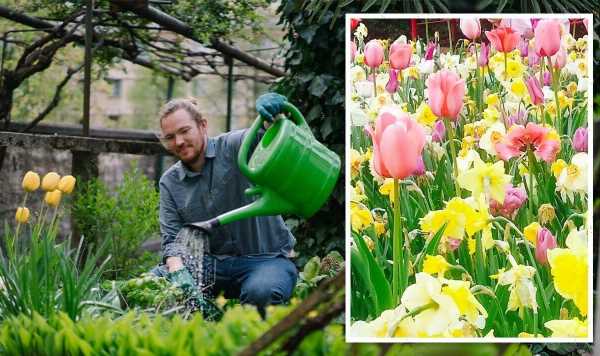Monty Don speaks about planting daffodil bulbs
We use your sign-up to provide content in ways you’ve consented to and to improve our understanding of you. This may include adverts from us and 3rd parties based on our understanding. You can unsubscribe at any time. More info
Perennial bulbs are a reliable addition to the garden, offering the promise of flowers which return year after year. However, in order to give perennials such as tulips and daffodils the best chance of blooming again, you need to make sure you are looking after them correctly. Not only does this mean caring for plants while they flower, it also means looking after them once they have died off.
Choose the right spot to plant bulbs
One of the best ways to ensure flowers return annually is by making sure you plant bulbs in the best spot.
For daffodils, this means choosing an area of your garden which is in full sun or partial shade.
The good news is that they are fairly easygoing flowers and are happy in most soil types as long as it is not too soggy.
For tulips, you may need to choose a slightly sunnier spot. According to experts from Flora Queen, this will “compensate for the climate”.
The experts explained: “There are a few things you can do to perennialize your tulips further.
“Location is crucial. Choose a sunny area to plant your bulbs and plant them deep (about 10 – 15cm) to give them a better chance of coming back.”


Cut flowers back annually after they have finished blooming
When your daffodils finish blooming, you can snap off the spent flower heads. Experts from Longfield Gardens say that although “this step is not essential” it will keep “the area looking neat”.
However, it is essential you do not touch any of the green foliage surrounding the daffodils, even once flowers have died.
Longfield gardens explained: “Daffodil bulbs use their foliage to create the food energy that’s required for another year of flowers.
“For this reason, it is important to allow the foliage to continue growing until it dies back naturally.
“Once the leaves are completely limp and yellow, they can be removed with a gentle tug or be trimmed back to soil level.”
For tulips, as soon as petals begin to fall away, it is time to take action.
Flora Queen’s experts said: “Cut off the dead heads from your tulips to help the plant conserve energy for the winter months.”
However, much like daffodils, their foliage should be conserved. The experts from Flora Queen explained: “Don’t cut back foliage until it has turned yellow which will be about a month after flowering.
“If you cut back the foliage too early the bulbs will be weaker the following year.”
DON’T MISS
The 7 plants in your garden you didn’t know were poisonous [REVEALED]
Lawn care: Can you kill weeds using baking soda? [EXPLAINER]
What to prune in May – four plant types to trim for spring [INSIGHT]
Reduce how often you water flowers
Although tulips and daffodils need frequent water while blooming, once their flowers have died off you can reduce this.
You should water daffodils generously while the plant is blooming, but Gardening Know How recommends keeping the soil “relatively dry when the plants are dormant during the summer”.
Similarly, overwatering tulips after they have flowered can weaken the bulbs.
Flora Queen said: “If you see standing water forming in your tulip bed then add something absorbent like bark chips to the soil, or dig them up and move them somewhere a little drier.”
Get the latest three-day weather forecast where you live. Find out by adding your postcode or visit InYourArea
Fertilise your bulbs
You can give both daffodils and tulips some extra energy while making next year’s blooms with a bit of fertiliser.
Tulips usually prefer one feed during the autumn and it is recommended to use bone meal fertiliser.
Daffodils, on the other hand, can benefit from a handful of bulb fertiliser or any general-purpose fertiliser when shoots poke through the ground in early spring.
Gardening Know How said: “Be sure to fertilise the soil around the daffodil plant, but keep the fertiliser off the foliage.”
Source: Read Full Article
